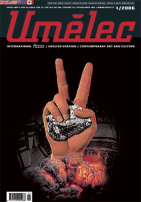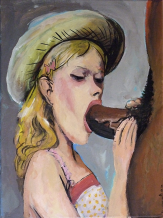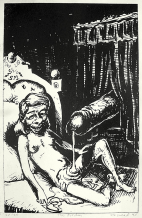| Zeitschrift Umělec 2006/1 >> TRENDS | Übersicht aller Ausgaben | ||||||||||||
|
|||||||||||||
TRENDSZeitschrift Umělec 2006/101.01.2006 Spunk Seipel | kommentar | en cs |
|||||||||||||
|
The art scene is a strange, fickle thing. Almost every year a new trend is proclaimed as if wanting to outdo the tempo of the fashion world flux. The one admired is the one who first spots a new trend which has to be exploited as quickly as possible, and which we have to abandon before it becomes assimilated – in order not to become outdated. Those who yesterday were considered Becher’s proteges (we reluctantly recall that until recently Ruff, Struth, Becker and Gursky were the stars of the international art scene) have now been cast aside, before that, or maybe at the same time epigones of Wolfgang Tillmans (whose name no one remembers anymore) and these days the Leipzig School (but today it is embarrassing to know more names than Neo Rauch) have also been dealt with the same nefarious blow, and somehow even video and the Young British Artists now belong among these folorn figures. At present the art world is arguing whether tomorrow drawing or sculpture will be in vogue. Some gallery owners are playing it safe and exhibit both.
However there are still a few whiners who warn about the potential collapse of the market with regard to the prices, which are rising along with the success of the few lucky ones. The students, whose pictures at the academy were bought up by the collectors before the paint could dry, not to mention the graduates, had no opportunity to develop and in a very short time they will burn out. The curmudgeons say it in a tone as if it was a disaster that a student could make a living off their paintings. If it doesn’t work after they finish school, at least they can say they had a good time and no one could promise that they would have become a better artist by earning money for paint and canvases by selling shoes. But the hype doesn’t only drive individual artists or schools. Whole world regions are becoming objects of speculation for collectors. In the early 90s it was the Russians who gave the market sufficient works, compatible with the West, and yet still exotic enough to bring something interesting into the living rooms of the bored rich. For a short time, the collector was taken by Latin America and later, under the leadership of Documenta 11 and Okwui Enwezor, by Africa, and finally by Asia, particularly China. Instead of appealing to their business partners for human rights, they take a Shanghai artist, who paints as if he grew up in New York and whose work they buy up, as a sufficient sign of democratic thinking. Even here the art appeases a guilty conscience. As an eternal memento of the collectors’ boom is the fate of Neue Wilden from Germany, who were briefly exploited by internationally active gallery owners and whose works today clutter the safes of buyers and museums, because all this painted stuff is no longer sellable or exhibitable. Certainly not for the prices once paid. Still often those moaning and groaning the loudest are those who are at the forefront of the trend-setting game, whether they be gallery owners, collectors, auctioneers, curators, journalists or artists. Isn’t it logical if you collect young art that you have to keep looking for new discoveries? A collector of contemporary art isn’t characterized so much by the quality of single art works as by the quantity of a collection, and who was the first to collect the artist. When describing famous collections, you often read first how many art works the collector bought, how many warehouses and museums their collection is deposited in and only in the end are a few artists’ names mentioned. They themselves don’t know what they have in empty factory buildings. There is something about the hype, as more and more people get interested in art, especially thanks to the well-known numbers of the foolish art market, but at the same time, hype takes the exclusivity away from art. And because no one likes that, as it would be too ordinary, one would lose their insider knowledge, or even their power, everyone looks for the culprit who caused all these trend spirals. It’s funny that all the protagonists shout aloud and point to each other, although they all profit from this system and cooperate intensively if it is necessary to take part in the steadily growing and newly founded art fairs. Everyone keeps accusing the others: artists, collectors, auction houses, gallery owners, journalists and art fair organizers. What is bizarre is when a successful artist moans that the price of their works is rising. Ok, they admit that the problem is more or less their fear that next year their prices will fall and they have to pay for the second Porsche. Then you must wonder why the people profiting complain about the rise of prices and chasing trends. Instead of rejoicing that there still are some people who want to spend their money on art, or to look at some questionable art works at exhibitions, they only gripe and complain. And no one speaks about the artists who can’t even attempt to live from their work. Those who for years of their development opt for their own language and expression are passed over in silence. These are the people who oppose particular developments in art trends. The silent ones don’t fit into the large-scale marketing of international art. But still they are the substance from which art lives. They are the creative pool from which the few successful ones are recruited in the end. And that is the rule in all fields of art operation. Many gallery owners put much more into it than they will get out of it financially. Self-employment is not only a theme for the artists. Certain collectors thus support some artists knowing that they will never be great and that they can help their own fame more as their discoverers. And the art market must be kept alive by all the participants regardless of how much they complain. The interest of the few real collectors mustn’t wane, especially because in Europe less and less money is available from state funds. Their interest is only possible through creating new trends. From the historical point of view it is nothing new. Remember Classical Modernism and how often it changed trends: Expressionism, Cubism, Dadaism, New Classicism, Surrealism, etc. And these are only the styles we remember. Even Rembrandt must have experienced a situation when his younger contemporaries advanced beyond him in style. However, the problem of acceleration in the provocation of new trends in art is that we aren’t speaking about design or cooking but about a thing which promises a higher value to us. So it is always being suggested when we are to reason the material value of an art work, which we actually don’t need for survival - but under certain circumstances it becomes a luxury good. The fact is that no one really speaks about the so-called higher values, as in the recent TV discussion after the Art Cologne. There collectors such as Harald Falckenberg from Hamburg or gallery owners such as Tania Grunert from New York only went on about side issues, about some artists’ new cars or questions about a gallery’s program – the answer was “simply good.” That is one way to get out of a difficult situation. None of them spoke concretely, not even while describing the collected or sold art. Concrete or abstract – that is unimportant as long as the artist likes wearing a red sweater, isn’t it? And that is maybe where the deeper essence of looking for new trends lies. One doesn’t want to pursue art too much. But with a large amount of money we can prepare toys, new methods of entertainment, with more efficiency for the ever increasing apthetic public. At one point they will watch Bruce Naumann’s videos, the next they will lumber through Thomas Hirschorn’s installation, and in the end they can nail a colorful painting by Thomas Scheibnitz on the wall. The faster the new trends are discovered the bigger the chances that the artists are young and sexy. Opening parties, dinners at the art fairs - that is what is exciting. And of course it is the same as in fashion: only the new trends invite you to buy, because a picture over the fireplace can hang there forever, pants will be around for a few years, but if you said that this or that style is not in anymore, that in five years it is already history, the whole business would collapse. And so we all tentatively wait for the hype after the next one is declared over.
01.01.2006
Empfohlene Artikel
|
|||||||||||||
|
04.02.2020 10:17
Letošní 50. ročník Art Basel přilákal celkem 93 000 návštěvníků a sběratelů z 80 zemí světa. 290 prémiových galerií představilo umělecká díla od počátku 20. století až po současnost. Hlavní sektor přehlídky, tradičně v prvním patře výstavního prostoru, představil 232 předních galerií z celého světa nabízející umění nejvyšší kvality. Veletrh ukázal vzestupný trend prodeje prostřednictvím galerií jak soukromým sbírkám, tak i institucím. Kromě hlavního veletrhu stály za návštěvu i ty přidružené: Volta, Liste a Photo Basel, k tomu doprovodné programy a výstavy v místních institucích, které kvalitou daleko přesahují hranice města tj. Kunsthalle Basel, Kunstmuseum, Tinguely muzeum nebo Fondation Beyeler.
|






























 New book by I.M.Jirous in English at our online bookshop.
New book by I.M.Jirous in English at our online bookshop.
Kommentar
Der Artikel ist bisher nicht kommentiert wordenNeuen Kommentar einfügen